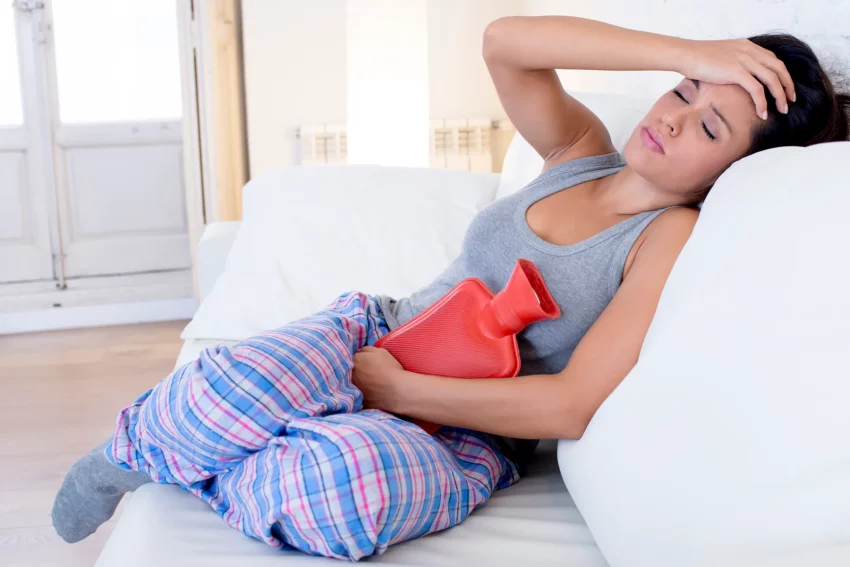Introduction
Period pain, also known as dysmenorrhea, is a common condition that affects many women during their menstrual cycle. While over-the-counter pain relievers are often used to alleviate the discomfort, some individuals may prefer natural options that provide relief without potential side effects. In this comprehensive guide, we will explore the top 10 natural options for managing period pain and discomfort. These natural remedies include lifestyle changes, dietary modifications, herbal remedies, and alternative therapies that can help ease menstrual cramps and promote overall well-being.
Table of Contents
I. Understanding Period Pain
- Types of Period Pain
- Causes and Symptoms of Period Pain
II. Natural Options for Managing Period Pain
- Heat Therapy
- Exercise and Physical Activity
- Dietary Modifications
- Herbal Remedies
- Essential Oils
- Acupuncture and Acupressure
- Yoga and Meditation
- Stress Management Techniques
- Transcutaneous Electrical Nerve Stimulation (TENS)
- Pelvic Floor Exercises
III. Heat Therapy
- Hot Water Bottle or Heating Pad
- Warm Baths or Showers
- Herbal Heat Packs
IV. Exercise and Physical Activity
- Aerobic Exercise
- Stretching and Yoga
- Pilates or Core Strengthening Exercises
- V. Dietary Modifications
- Increase Water Intake
- Reduce Salt and Sugar Consumption
- Omega-3 Fatty Acids
- Magnesium-rich Foods
- Herbal Teas
- VI. Herbal Remedies
- Ginger
- Chamomile
- Cinnamon
- Cramp Bark
- Turmeric
- VII. Essential Oils
- Lavender Oil
- Clary Sage Oil
- Peppermint Oil
- Rosemary Oil
- Marjoram Oil
VIII. Acupuncture and Acupressure
- Acupuncture
- Acupressure Points
- IX. Yoga and Meditation
- Restorative Yoga Poses
- Meditation and Deep Breathing Exercises
- X. Stress Management Techniques
- Stress Reduction Strategies
- Relaxation Techniques
XI. Transcutaneous Electrical Nerve Stimulation (TENS)
- How TENS Works
- TENS Unit Usage
XII. Pelvic Floor Exercises
- Benefits of Pelvic Floor Exercises
- Kegel Exercises
XIII. Conclusion
I. Understanding Period Pain
- Types of Period Pain:
There are two types of period pain: primary dysmenorrhea and secondary dysmenorrhea. Primary dysmenorrhea is the most common and occurs without any underlying medical condition. Secondary dysmenorrhea is caused by an underlying condition, such as endometriosis or uterine fibroids.
- B. Causes and Symptoms of Period Pain:
Period pain is primarily caused by the contraction of the uterus as it sheds its lining. This contraction can lead to cramping and discomfort. Symptoms may include lower abdominal pain, backache, headache, fatigue, and mood changes.
II. Natural Options for Managing Period Pain
- Heat Therapy:
Applying heat to the lower abdomen can help relax the uterine muscles and alleviate pain. Heat therapy options include using a hot water bottle, heating pad, warm baths, or herbal heat packs.
- B. Exercise and Physical Activity:
Engaging in regular exercise and physical activity
can help reduce period pain by increasing blood flow, releasing endorphins, and promoting overall relaxation. Aerobic exercises, stretching, yoga, and Pilates are beneficial options for managing period pain.
C. Dietary Modifications:
Making certain dietary modifications can have a positive impact on period pain. Increasing water intake, reducing salt and sugar consumption, incorporating foods rich in omega-3 fatty acids and magnesium, and drinking herbal teas known for their calming and anti-inflammatory properties can help alleviate discomfort.
D. Herbal Remedies:
Several herbs have been traditionally used to alleviate period pain. Ginger, chamomile, cinnamon, cramp bark, and turmeric are known for their anti-inflammatory and analgesic properties. These herbs can be consumed as teas, added to meals, or taken in supplement form.
E. Essential Oils:
Certain essential oils possess pain-relieving and muscle-relaxing properties that can provide relief from menstrual cramps. Lavender oil, clary sage oil, peppermint oil, rosemary oil, and marjoram oil can be diluted and applied topically or used in aromatherapy to reduce pain and promote relaxation.
F. Acupuncture and Acupressure:
Acupuncture and acupressure involve the stimulation of specific points on the body to relieve pain and promote balance. Acupuncture, performed by a trained professional, uses thin needles to target specific points, while acupressure applies pressure to the same points using fingers or specific tools.
G. Yoga and Meditation:
Yoga and meditation can help manage period pain by promoting relaxation, reducing muscle tension, and improving blood circulation. Restorative yoga poses, deep breathing exercises, and mindfulness meditation techniques can be effective in alleviating pain and discomfort.
H. Stress Management Techniques:
Stress can exacerbate period pain, so managing stress is crucial. Adopting stress reduction strategies such as practicing self-care, engaging in hobbies, seeking social support, and using relaxation techniques like deep breathing, progressive muscle relaxation, and guided imagery can help alleviate period pain.
I. Transcutaneous Electrical Nerve Stimulation (TENS):
TENS is a non-invasive therapy that uses low-voltage electrical currents to relieve pain. It involves placing electrode pads on the skin near the area of pain, which deliver electrical impulses to disrupt pain signals and provide relief.
J. Pelvic Floor Exercises:
Strengthening the pelvic floor muscles through exercises known as Kegel exercises can help reduce period pain. These exercises improve blood circulation, support the uterus, and alleviate cramping
XIII. Conclusion
Managing period pain naturally involves adopting a holistic approach that incorporates various strategies. Heat therapy, exercise, dietary modifications, herbal remedies, essential oils, acupuncture, yoga, meditation, stress management techniques, TENS therapy, and pelvic floor exercises are effective options for alleviating period pain and discomfort. It’s important to remember that each individual may respond differently to these natural remedies, so it may require some experimentation to find the best combination of strategies that work for you. As always, consulting with a healthcare professional is advisable, especially if you have underlying health conditions or are unsure about incorporating any of these natural options into your routine. By empowering yourself with knowledge and exploring these natural remedies, you can find relief and improve your overall well-being during your menstrual cycle.
- Top 10 Natural Options For Period Pain And Discomfort - June 10, 2023
- CBD For Back Pain - June 10, 2023
- CBD Mother’S Day Gift Ideas 2021 - June 10, 2023

